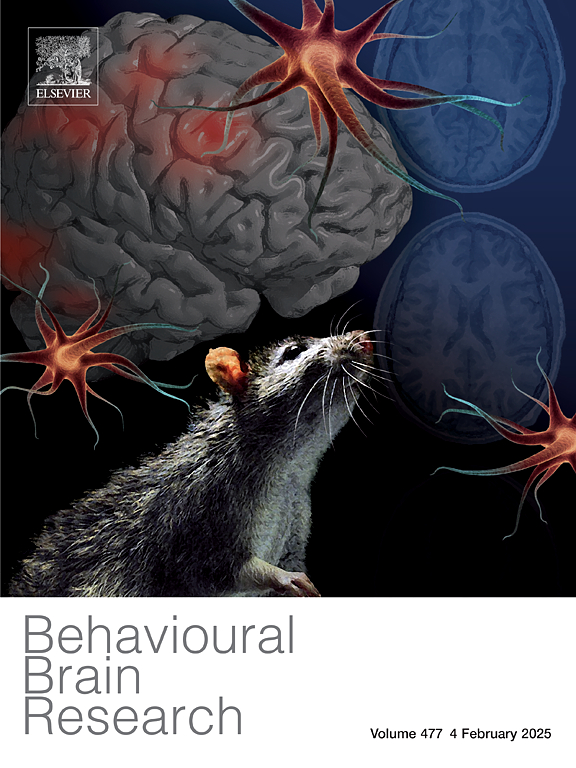Oral or intranasal angiotensin-(1-7) improves anxiety and depression-like behaviors in mice subjected to allergic pulmonary inflammation
IF 2.3
3区 心理学
Q2 BEHAVIORAL SCIENCES
引用次数: 0
Abstract
Allergic asthma is a chronic respiratory disease characterized by airway inflammation and hyperresponsiveness, that has a challenging management when associated with anxiety and depression, which affects around 50 % of patients with difficult-to-control asthma. Angiotensin-(1-7) [Ang-(1-7)], a key mediator of the renin-angiotensin system, has demonstrated the ability to attenuate airway remodeling, hyperreactivity and to promote resolution of lung inflammation. Furthermore, Ang-(1-7) exhibits anxiolytic and antidepressant effects when administered into the brain. Here we investigated whether peripheral administration of Ang-(1-7) by two different routes could alleviate depressive and anxiety-like behaviors and inflammation in asthmatic mice. Male Balb/c mice, 8–10 weeks old, underwent sensitization and challenge with ovalbumin. Asthmatic mice received either an oral or intranasal formulation of Ang-(1-7) included in hydroxypropyl-β-cyclodextrin (HPβCD). Both oral and intranasal Ang-(1-7) treatments induced reduction in lung inflammation, and effectively ameliorated depressive and anxiety-like behaviors, as shown in elevated plus maze, open field, and tail suspension tests. Notably, intranasal Ang-(1-7) decreased levels of TNF-α and IL-6 in the prefrontal cortex, and, regardless of treatment, there was an elevation in IL-10. Additionally, in other asthmatic animals, ICV administration of Ang-(1-7), which resulted in the expected attenuation in depressive and anxiety-like behaviors, did not significantly reduce lung inflammation, suggesting the improvement in behavioral tests following peripheral treatment with Ang-(1-7) cannot be solely attributed to a decrease in pulmonary inflammation. The data of the present study showed that both intranasal and oral administration of Ang-(1-7) not only alleviates pulmonary inflammation but also mitigates stress-coping behaviors, indicating this peptide as a promising therapeutic candidate for enhancing the treatment and quality of life for patients with asthma.
口服或鼻内血管紧张素-(1-7)可改善过敏性肺部炎症小鼠的焦虑和抑郁样行为。
过敏性哮喘是一种以气道炎症和高反应性为特征的慢性呼吸系统疾病,当与焦虑和抑郁相关时,其管理具有挑战性,影响约50%的难以控制的哮喘患者。血管紧张素-(1-7)[Ang-(1-7)]是肾素-血管紧张素系统的关键介质,已被证明具有减轻气道重塑、高反应性和促进肺部炎症消退的能力。此外,Ang-(1-7)在进入大脑时表现出抗焦虑和抗抑郁作用。本研究通过两种不同途径外周给药Ang-(1-7)是否能减轻哮喘小鼠的抑郁、焦虑样行为和炎症反应。雄性Balb/c小鼠,8-10周龄,进行致敏和卵清蛋白攻击。哮喘小鼠口服或鼻内注射羟丙基-β-环糊精(hp -β cd)中含有的Ang-(1-7)制剂。口服和鼻内的Ang-(1-7)治疗均可减少肺部炎症,并有效改善抑郁和焦虑样行为,这在升高加迷宫、空旷场和悬尾试验中得到了证实。值得注意的是,鼻内Ang-(1-7)降低了前额叶皮层中TNFα和IL-6的水平,并且,无论治疗方式如何,IL-10都有升高。此外,在其他哮喘动物中,ICV给药Ang-(1-7)虽然导致抑郁和焦虑样行为的预期减弱,但并未显著减少肺部炎症,这表明外周治疗Ang-(1-7)后行为测试的改善不能仅仅归因于肺部炎症的减少。本研究的数据显示,经鼻和口服给药Ang-(1-7)不仅可以缓解肺部炎症,还可以减轻应激应对行为,表明该肽是一种有希望的治疗候选者,可以改善哮喘患者的治疗和生活质量。
本文章由计算机程序翻译,如有差异,请以英文原文为准。
求助全文
约1分钟内获得全文
求助全文
来源期刊

Behavioural Brain Research
医学-行为科学
CiteScore
5.60
自引率
0.00%
发文量
383
审稿时长
61 days
期刊介绍:
Behavioural Brain Research is an international, interdisciplinary journal dedicated to the publication of articles in the field of behavioural neuroscience, broadly defined. Contributions from the entire range of disciplines that comprise the neurosciences, behavioural sciences or cognitive sciences are appropriate, as long as the goal is to delineate the neural mechanisms underlying behaviour. Thus, studies may range from neurophysiological, neuroanatomical, neurochemical or neuropharmacological analysis of brain-behaviour relations, including the use of molecular genetic or behavioural genetic approaches, to studies that involve the use of brain imaging techniques, to neuroethological studies. Reports of original research, of major methodological advances, or of novel conceptual approaches are all encouraged. The journal will also consider critical reviews on selected topics.
 求助内容:
求助内容: 应助结果提醒方式:
应助结果提醒方式:


